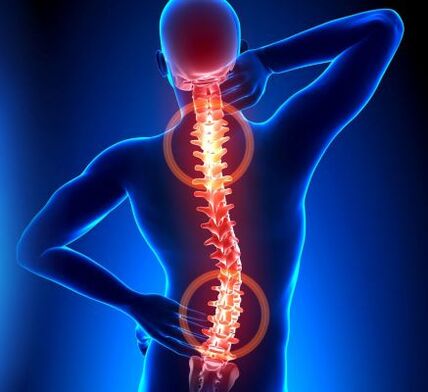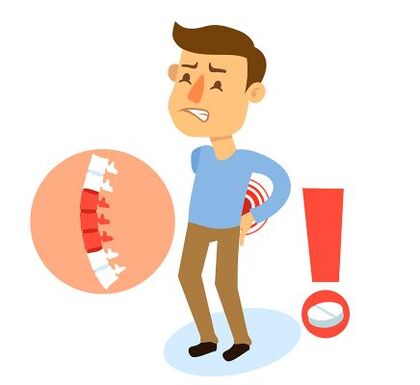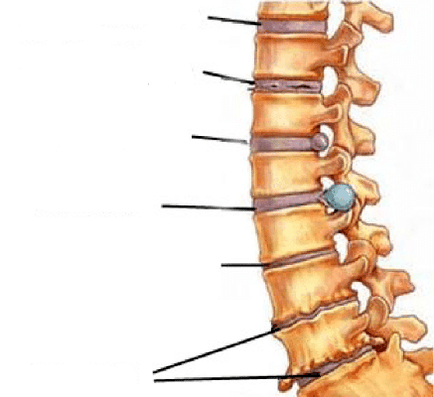Imagine that in the 21st century, osteochondrosis is diagnosed in 50-80% of the world's population. The numbers are not small, and the most important thing is to "rejuvenate" the disease. Previously, the first symptoms did not appear earlier than 35 years, but now the first symptoms are diagnosed in adolescents. Often, the tendency to osteochondrosis is observed in people with unequal load on the spine. This can be a wrong posture, the habit of carrying a bag in one bag, sitting in one place for a long time, injury, excessive sports load and, of course, age-related changes.
"Most people have heard of osteochondrosis, but not everyone knows what it is. "
What is osteochondrosis?

Osteochondrosis is a pathology of the spine characterized by degenerative damage to the intervertebral discs and adjacent bone tissue, which leads to the destruction of the vertebral bodies and joint surfaces.
Unfortunately, when the first pain in the back appears, almost no one consults a doctor, which leads to the detection of the disease in already serious stages. At an early stage, the disease is treated very effectively, because the changes in the spine are not critical, but over time, the process becomes irreversible.
The main sign that you are already developing osteochondrosis is pain in the neck, back or lower back. In a more advanced form, the pain "radiates" to the chest, arms, shoulders, legs and other parts of the body.
Depending on the location, osteochondrosis is divided into several types:
- Cervical osteochondrosis.
- Chest osteochondrosis.
- Lumbar osteochondrosis.
Symptoms and signs of osteochondrosis
Clinical manifestations are caused by damage to nerve tissue and blood vessels located near the affected area.
- Back pain.
- The feeling of "lumbago" after physical exertion.
- Poor posture and eventually scoliosis.
- Disorders of skin sensitivity in certain areas of the body.
- Matching.
- Dizziness and nausea due to impaired blood supply.
- Headache.
Osteochondrosis can have a variety of symptoms and signs, so it is not always easy to detect at the first signs. Get periodic checkups and do not delay seeing a doctor at the first suspicion of osteochondrosis.
Causes of osteochondrosis

There can be many reasons for the development of osteochondrosis. As a rule, the lack of proper respect for the spine leads to this disease, although not at a young age, but up to 50 years.
Think about how you sit, how you sleep, whether you have a comfortable pillow every day, and whether you always carry weight in one hand and put on the right load when exercising, because all of this can lead to irreversible consequences on your spine. . .
The reasons for the development of osteochondrosis can be:
- Genetic predisposition.
- Nervous exhaustion of the body.
- Poor posture during active growth.
- Wear uncomfortable shoes.
- Wear heels at an early age.
- Physical overload of the body.
- Overweight.
- Sedentary and sedentary lifestyle.
- Weight loss will be followed by fatigue and constant tiredness.
- Frequent lifting of loads.
- Vibration loads on the body.
- Dehydration of the body.
- Hypothermia of the body.
"Be aware that being overweight and sedentary will cause back problems over time! "
At risk:
- Drivers.
- Office workers.
- Carriers.
- Pregnant women.
- Fat.
- Professional athletes.
Take care of your health and lead a healthy lifestyle.
Stages of development of osteochondrosis

None of the diseases start suddenly and immediately. Osteochondrosis is no exception. There are 4 main stages in the development of osteochondrosis.
- Primary dystrophic changes in the intervertebral cartilage. Dehydration of the disc, micro-cracks, loss of elasticity - all this is already happening in your spine, you feel practically no change, but they are still there and you can pay attention to them. If you start to feel uncomfortable during prolonged sitting or a small pain after physical exertion, do not waste time, consult a doctor.
- Narrowing of the intervertebral space and compression of nerve endings and the appearance of pain in certain areas of the lower back. The pain syndrome will appear each time with a sharp turn and bend. This stage is difficult to miss and, of course, can not be ignored.
- Erosion of intervertebral cartilage tissue. Symptoms of pain manifest themselves and can cause numbness of the limbs. It is impossible to eliminate pain without medication. At this stage, strict treatment is required by following a regimen and taking medication.
- The last and most serious stage. Because the intervertebral cartilage is completely destroyed, osteochondrosis is already irreversible. In such cases, surgery is usually required.
Advanced osteochondrosis can cause partial or complete paralysis. In order not to make the condition critical, it is necessary to start treatment in time in the early stages of osteochondrosis.
Treatment of osteochondrosis
Treatment of spinal osteochondrosis requires an individual approach to each patient. There is no standard and unified treatment method. The patient's age, physical condition, causes of osteochondrosis and many other factors are taken into account. Of course, each treatment has common features:
Medication for osteochondrosis

Osteochondrosis cannot be treated with medication alone, but it plays a key role in reducing the severity of symptoms, improving blood supply and tissue regeneration. Complete elimination of the disease requires a holistic approach and the proper condition of the body for the rest of your life. Medication for osteochondrosis consists of taking several groups of medications.
- First of all, it is necessary to eliminate the pain that interferes with a normal lifestyle. NSAIDs are used for this purpose - non-steroidal anti-inflammatory drugs. (Ketoprofen, Ibuprofen, Ketorolac).
- Chondroprotectors and vitamins are prescribed to restore cartilage tissue after the symptoms of pain have disappeared. Such drugs prevent further destruction of the intervertebral discs and reduce inflammation. Such drugs, unlike analogues, include Glucosamine, which does not need to be injected. One bag of powder is enough to dissolve in a glass of water and take orally. This method of application helps to better absorb the drug and eliminates the discomfort that arises during the injection.
- Drugs that stimulate blood microcirculation.
- Local analgesics.
Physiotherapy for osteochondrosis

Treatment of osteochondrosis with physiotherapy is a fairly effective measure and, most importantly, painless and has virtually no contraindications. Such procedures help to relieve inflammation, relieve spasms and relieve nerve compression. Physiotherapy includes the following procedures:
- Electrophoresis.
- Magnetotherapy.
- Phototherapy.
- Shock wave therapy.
- Mud treatment.
It is important to know that some physiotherapy procedures may not be used during an exacerbation. Treatment of osteochondrosis with physiotherapy is prescribed only by a doctor and in combination with medication.
Physiotherapy and massage for osteochondrosis
Physiotherapy exercises for osteochondrosis help to form a muscular corset that will help support the patient's back. The set of exercises is selected individually for each patient. Exercises for 3 stages are performed only while stretching, smooth and preferably under control.
Massage therapy for osteochondrosis is also widespread. The main thing is that the massage is done by a specialist who will not damage your spine. After the session, you should feel muscle relaxation, clamp release, and general relaxation. Hand massage improves blood circulation. It is better to abandon this method of treatment in the acute stages of the disease.
Treatment of cervical osteochondrosis

A patient with cervical lumbar osteochondrosis feels sharp pain in the head, neck, arms and shoulder girdle. "Flies", tinnitus and spots tremble in front of the eyes. As a rule, in the early stages the patient goes to examine the head and does not suspect that the issue is completely different. It is prescribed for cervical osteochondrosis.
- The most common agnioprotectants for morning dizziness (Pentoxifylline).
- Chondroprotectors (glucosamine, chondroitin sulfate) that prevent further destruction of cartilage tissue, reduce inflammation, relieve pain and restore joint mobility.
- Antidepressants, which should sometimes be used by patients because of the harmful effects of constant pain on the psyche and the development of insomnia and depression. (Doxylamine).
- Vitamins that will improve the general condition of the body.
- Anti-colvuzants for headaches that interfere with the lives of patients.
- NSAIDs are prescribed in the acute period to relieve pain.
Treatment of thoracic osteochondrosis
With osteochondrosis of the thoracic spine, there is severe pain in the front of the chest, and breathing may be frequent and difficult. There may be severe pain when turning and bending the shoulder blades. Thoracic osteochondrosis is difficult to diagnose because the pain is not felt directly in the spine and the symptoms are more similar to heart, lung or kidney disease. Fortunately, this type of osteochondrosis is very rare, and the cause of most cases is scoliosis.
Treatment of lumbar osteochondrosis
Lumbar osteochondrosis is currently the most common type. This is because this part of the spine is under the greatest stress. At first there is a dull pain in the lower back, then the pain begins to spread to the legs and can cause numbness of the lower extremities. Flexion and extension problems occur. The key in such cases is to start timely treatment of osteochondrosis of the spine and take comprehensive measures. There are a few rules to follow:
- Limit physical activity.
- Take all prescribed medications.
- Get prescribed physiotherapy.
- Take a special massage course.
- Get rid of excess weight if necessary.
Surgery may be required for recent osteochondrosis of the spine due to improper treatment and non-compliance with recommendations.
Which doctor treats osteochondrosis?
If you feel pain in the spine and suspect that you have osteochondrosis, you should first make an appointment with a neurologist, vertebrologist, orthopedist and a therapist who will refer you to a surgeon based on your complaints.
How is osteochondrosis treated?
Many patients wonder how long the treatment of osteochondrosis will last. No one will give you an exact answer, but the main symptoms of the disease, as a rule, will pass in 1-3 months, the situation needs to continue.
Is it possible to get rid of osteochondrosis forever?
Everything depends on the stage of discovery. If the patient returns in 1-2 stages, you can get rid of osteochondrosis forever with proper treatment and following all the rules. In the later stages, unfortunately, it will not be possible to completely get rid of the disease.
Orthopedic pillow
If you are diagnosed with cervical osteochondrosis, you may need an orthopedic pillow. This pillow will improve the quality of your sleep and will not continue to deform your spine. You can go to a specialty store, where consultants will show you all the options for pillows and inform you about the prices.
































